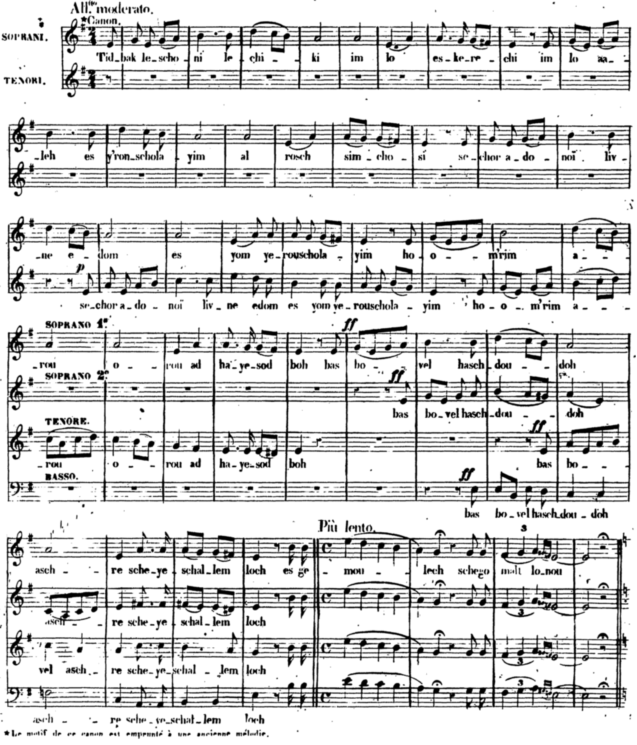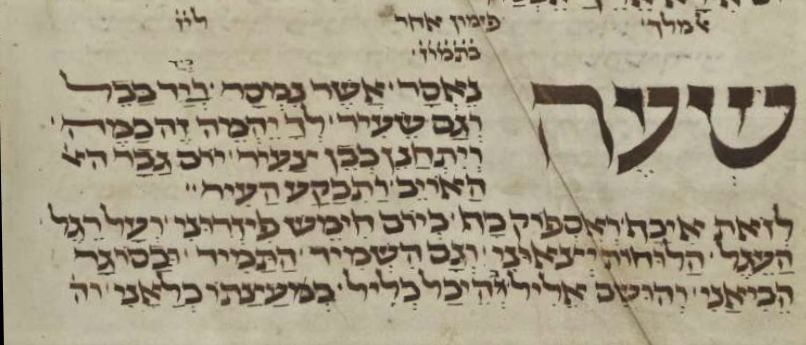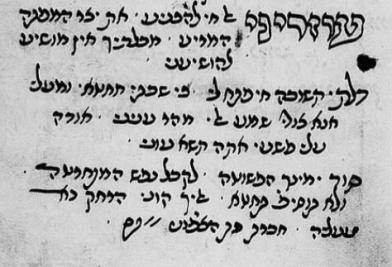She'eh ne'esar, Frankurt am Main tradition, Mordecai Breuer, NLI, CD 5124
The Fall of Jerusalem in Song: The Ashkenazi Melody She’eh ne’esar
In his pioneer publication Hebrew Hymn Melodies: The Rise and development of a Musical Tradition (Tel Aviv, 1970), Hanoch Avenary set a new bar in the musicological study of the piyyut. His insights on a selection of different texts suggested a comprehensive method for addressing the musical aspects of Hebrew liturgical poetry from an evolutionary diachronic perspective. Among the texts he selected was the seliha “She’eh ne’esar,” a penitential hymn (Avenary debatably defines it as an “elegy,” qinnah in Hebrew) for the Seventeenth of Tammuz, a fast day in Jewish tradition marking the breach of Jerusalem’s fortifications leading to the destruction of the Second Temple. Eventually this date was associated with other catastrophes in Jewish history. In spite of its prominence in Jewish historical memory, this fast day has not generated nearly as much Hebrew poetical creativity as the Ninth of Av, the fast day marking the fall of the Jerusalem Temple which occurs twenty-one days after the Seventeenth of Tammuz, ending a three weeks’ period of bereavement in the Jewish calendar. For a commentary on the rich content of this poem (in Hebrew) see here.
Within his analysis of the musical and textual development of the piyyut genre (and of Jewish music in general), Avenary placed “She’eh ne’esar” at an historical point when, in his view, a different, new pattern of setting music to piyyutim appeared. This is “a pattern of rhythmic bars and a symmetric structure [that] gives it the stamp of the common European song.” Melody emerges in this case from the poetic form and meter of the text. In his words, “the symmetrical bars are the musical counterpart of the constant numbers of syllables adhered to in a regular meter and the set of well-balanced periods corresponds to the poetic stanza.” This compositional model originated in Al-Andalus, and stems from the adoption by Iberian Hebrew poets of the Arabic system of scansion. One of the masters of this then new poetic style was the author of our poem, Shlomo Ibn Gabirol (ca. 1020-1058).
Recent research has shown that these historical certainties have to be taken with some reservations. For example, what is “a common European song” is highly conjectural. However, a critique of Avenary’s analysis is not the subject of this essay as others have already noticed some shortcomings in this text. Indeed, as part of his acerbic approach to Israeli musicology in general and to the work of Avenary in particular, Eric Werner, while discussing 'She'eh ne'esar' in his A Voice Still Heard: The Sacred Song of the Ashkenazic Jews (University Park and London, 1976, pp. 100-101) quoting Idelsohn's work (see below) and Emanuel Kirschner's printed lecture 'Ueber mittelalterliche hebraeische Poesien und ihre Singweisen' (Blaubeuren, 1914), viciously remarks that this is 'a fair example of Israeli musical scholarhip.' (ibid., p. 305, note 47)
Rather than criticize previous research, we would like to address two phenomena worth attention in relation to “She’eh ne’esar”: the well-entrenched presence of Sephardic poetry in Ashkenazi prayer, and the overall musical style of the melody which Avenary choose as his point of departure, and upon which his hypothesis is based. Before discussing this melody, a few words about the structure of the poem are called for.
The Text
שְׁעֵה נֶאֱסַר אֲשֶׁר נִמְסַר בְּיַד בָּבֶל וְגַם שֵׂעִיר
לְךָ יֶהֱמֶה זֶה כַּמֶּה וְיִתְחַנֵּן כְּבֶן צָעִיר
מוּלְךָ צוּר בְּלֵב עָצוּר הֶמְיַת מֵעָיו יַסְעִיר
יוֹם גָּבַר הָאוֹיֵב וַתִּבָּקַע הָעִיר
לְזֹאת אִכַּף וְאֶסְפּוֹק כַּף בְּיוֹם חָמֵשׁ קְרָאוּנִי
עֲלֵי רֶגֶל הָעֵגֶל הַלּוּחוֹת יְצָאוּנִי
וְלָכַד צַר עִיר מִבְצָר וּבַסּוּגַר הֱבִיאַנִי
וְגַם הִשְׁמִיד הַתָּמִיד וּמֵעֲשׂוֹתוֹ כְּלָאַנִי
וְהוּשַׂם אֱלִיל בְּהֵיכַל כְּלִיל וְדָתְךָ צָר בָּאֵשׁ הִבְעִיר
מְאֹד אֶתְחַל וָאֶתְחַלְחַל בְּיוֹם שַׁדַּי חֲשָׂפַנִי
וְהַשְּׁפִיפוֹן מִצָּפוֹן כְּשִׁבּוֹלֶת שְׁטָפַנִי
וְנָהַג שְׁבִי אֶרֶץ צְבִי כְּמוֹ כַּדּוּר צְנָפַנִי
וְיוֹם חָשַׁךְ מְאוֹר שֵׁשַׁךְ לְיַד פָּרַס דְּחָפַנִי
וְשָׁלַח יָד אִישׁ צַיָּד וְהַצָּפִיר וְהַשָּׂעִיר
הוֹד לִבִּי וּמִשְׂגַּבִּי הֲלָעַד אַפְּךָ יֶעֱשַׁן
הֲלֹא תִרְאֶה עַם נִלְאֶה אֲשֶׁר הָשְׁחַר כְּמוֹ כִּבְשָׁן
גְּדוֹר פִּרְצִי בְּבֶן פַּרְצִי וּמֵחֶדֶק לְקוֹט שׁוֹשָׁן
בְּנֵה בֵּית זְבוּל וְהָשֵׁב גְּבוּל הַכַּרְמֶל וְהַבָּשָׁן
וְעַיִן פְּקַח וְנָקָם קַח מֵאֵצֶר וּמִדִּישָׁן
שְׁפוֹט אֵלֶם וְאָז יְשַׁלֵּם הַמַּבְעֶה וְהַמַּבְעִיר
“She’eh ne’esar” is defined in most medieval Hebrew sources as a pizmon. It consists of four stanzas with differing number of lines (four, five, five, and six respectively) with the acrostic Sh-L-M-H. While all the lines in the opening stanza have the same rhyme on [ir], the other three stanzas have a different rhyme except for the last line, which rhymes with the opening stanza on [ir]. This rhyme scheme, called by Hebrew poetry scholars me’ein ezori (“quasi muwashshah”) indicates that the last line of each stanza is part of a refrain, continuing into the last line of the opening stanza to be sung by the congregation. To make the scheme even more sophisticated, the poet divided each line into three hemistiches, and the first two hemistiches of each line rhyme among themselves, each line in a different rhyme.
Defining the poetical meter of “She’eh ne’esar” is complicated. Avenary claimed that it is in the hazajArabic meter (u---, u---), which was adapted for widespread use in Hebrew poetry. Yet, in more than one section there is a “shortage” of short syllables, making it difficult to fully justify a clear and stable hazaj. The scholarly edition of Ibn Gabirol’s religious poetry (Shirei qodesh le-rabbi Shlomo ibn Gabirol, according to manuscripts with commentaries, sources, versions, introduction, indices, glossary and bibliography by Dov Yarden, Jerusalem, 1986, vol. 1, pp. 446-7) defines the meter as syllabic-grammatical (short syllables are disregarded in the counting), with twelve syllables per line divided in 3+3+6.
The poem already appears in one of the oldest Ashkenazi orders of prayers, dated as early as the twelfth century (Ms. Or. fol. 1224 Staatsbibliothek zu Berlin - Preußischer Kulturbesitz, fol. 148, more likely from the thirteenth century). “She’eh ne’esar” is found in the last of a series of five folios with songs for the Seventeenth of Tammuz, all framed by the selihot refrain (the Thirteen Attributes), with the title “another pizmon for the Seventeenth of Tammuz.”

Figure 1: Staatsbibliothek zu Berlin - Preußischer Kulturbesitz, Ms. Or. 1224, fol. 148a
Of all these songs for the fast, only “She’eh ne’esar” has continued to be sung with a distinctive melody up until the present time. The song probably made its inroads into Ashkenaz via Provence. It is included also in the order of prayers for the Four Fasts (Ms. Vatican, dated 1389). In this source, “She’eh ne’esar” appears twice. It is included among the songs for another fast day, the Tenth of Tevet, which marks the Babylonian siege of Jerusalem which preceded the destruction of the First Temple of Jerusalem (fol. 6a), and for the customary Seventeenth of Tammuz (fol. 17a). One of the first versions in print appears in Selihot according to the Ashkenazi minhag (Venice, 1548).
Although our piece is a poem by one of medieval Spain’s most distinguished poets, “She’eh ne’esar” appears more infrequently in Sephardic liturgical music sources. One source shows that in medieval Castile the poem had its own recognizable melody that could be applied to other poems. The Ms. Heb. 7220 of the National Library of Israel (= Ms. 24 of the Jewish Community of Vienna Library), dated before the year 1465, includes the “Tikkun Tefillat Atzirah,” a rare ritual based on Mishnah Ta’anit 2:2-5. This order of prayers is attributed in this manuscript to the Spanish kabbalist R. Joseph ben Abraham Gikatilla (1248 – after 1305), a student of Abraham Abulafia. In fol. 18b-19a of this manuscript there is an elegy opening “Avi yetomim she’eh ‘agumim” with the title “a pizmon [to be sung to the] melody [of] She’eh ne’esar.” Remarkably, “She’eh ne’esar” is also included in the Tikhkal, the general prayer book of the Yemenites Jews.
In the course of time the text of “She’eh ne’esar” underwent may alterations and changes in the Ashkenazi sources. Amendments already appear in a very early stage in the transmission of the text (see Figure 2). Once written down, these fluctuations of the text became a fixed feature.

Figure 2. Staatsbibliothek zu Berlin - Preußischer Kulturbesitz, Ms. Or. 1224, fol. 148b, showing textual amendments
The melody
The point of departure for Avenary’s discussion is the earliest printed specimen of the “She’eh ne’esar” melody, included in Salomon Sulzer’s second volume of Schir Zion (1865, no. 324), named there as “Alte Melodie.” Sulzer’s melody, Avenary argued, is in the AAB form. While A is a phrase with a clear rhythmic pattern, B has, based on its melismatic and recitative character, a looser beat. The melodic movement of B has two parts, the first of which descends to the sub-tonic, while the second one, ending of course on the tonic, is highly reminiscent of the ending phrase in the cantillation of the Book of Lamentations, the biblical book recited during the Ninth of Av.

Figure 3. Salomon Sulzer, Schir Zion, vol. 2. Rendition by Gabrielle Pescador.
The elegant analysis by Avenary presents difficulties. First among these is the AAB form. Sulzer set the tune only to the first two lines (AA) and to the last one (B) of the first stanza. The reason for this fragmentation is found in Ashkenazi prayer books, which have traditionally presented altered, fragmented versions of the “She’eh ne’esar” text. One of these recurring alterations is the omission of the third line of the first stanza, found for example in the widespread Seder selihot “according to the custom of Fürth that our fathers told us that they took upon themselves to print according to the order and custom of the city of Nuren Berg that existed from times immemorial” (Sulzbach, 1757). In this publication the poem was altered to create the acrostic “ShLoMoH HLeVY” and included indications that congregation was to repeat the opening line as a refrain between the stanzas.
Sulzer’s setting then reflects an old Ashkenazi practice codified in printed texts. His melody cannot of course accommodate the rest of the stanzas that have more lines. Thus, the form of the melody is actually Ax B, whereas x represents the varying number of lines in each stanza while B is only used for the last line.
Interestingly, Avenary did not mention that Abraham Baer included Sulzer’s “She’eh ne’esar” in his influential compendium Ba’al tefillah (1877, no. 225) without mentioning his source. This exact replication of Sulzer’s melody shows how dissemination via written sources led to a rapid diffusion of Jewish liturgical melodies in the modern era.
Gershon Efros in his Cantorial Anthology (vol. V, p. 54) replicates Sulzer’s melody once again with an attribution to “Sulzer-Wodak coll.” From this credit, one learns that Efros knew also the version by the Hungarian-born Mayer Wodak (1838?-1902) included in his Hamnazeah (1898, no. 66). Though similar in its modal minor setting and melodic contour to Sulzer’s, Wodak’s version is rhythmically different, being in a ternary meter (3/8), the only printed example of “She’eh ne’esar” in such meter (see more below). Yet, Efros’ version is almost identical to the one by Sulzer rather than Wodak’s.

Figure 4. Mayer Wodak, Hamnazeah, 1898, no. 66
Avenary mentioned that the “Western” melody, i.e. Sulzer’s, is similar to German folk melodies, some documented as early as the fifteenth century (“Es wonet lieb bei liebe”, no. 19 in Franz M. Böhme, AltdeutschesLiederbuch, Leipzig: Breitkopf & Härtel, 1913). In fact, this information was taken from Idelsohn’s introduction to volume 7 of the Thesaurus of Oriental Jewish Melodies (1932, p. xxxix), which also refers to other possible German sources for this melody. Idelsohn included “She’eh ne’esar” in this volume dedicated to the German Jewish liturgical tradition (no. 295) in the amorphous section of titled “well-known melodies.”

Figure 5. A. Z. Idelsohn, Thesaurus of Oriental Hebrew Melodies, vol. 7, no. 295
This version is similar to Sulzer’s and yet, considering the differences, Idelsohn may have well written it down from his own personal memory (in his youth he was cantor in Germany). Notice also that Idelsohn provided two different versions of the B phrase of the melody, a sign of the variable character of this improvised melodic movement reminiscent of the Lamentations’ cantillation. Let’s note here that Idelsohn’s comparative approach of Western Ashkenazi metric melodies such as “She’eh ne’esar” with non-Jewish sources implies that he believed in a strong interaction of German Jews with their gentile musical surroundings. Eric Werner and later on Hanoch Avenary continued this approach.
Another version of the melody, identified by Avenary as the “Eastern European” one, is quoted from Idelsohn in volume 8 of his Thesaurus of Oriental Jewish Melodies, dedicated to the Eastern European Ashkenazi liturgy (1932, no. 211). This melody is in a different mode, freygish. Indeed Idelsohn included it under the section of “Melodien in Ahavoh Rabboh.” What Avenary did not mention at all is that Idelsohn brought yet another melody for “She’eh ne’esar” (no. 210). Although this second melody preserves the Ax B melodic structure, it is in plagal minor and in a psalmodic style that sets it out from all other versions. Its 6/8 meter is reminiscent of Wodak's version.

Figure 6. A. Z. Idelsohn, Thesaurus of Oriental Hebrew Melodies, vol. 8, nos. 210 and 211
Idelsohn was a bit cryptic in his commentary on the relationship between these two melodies (p. xix): “The first four bars of no. 211 are based on a variation of no. 210, and they seem to be a replica of the German version (vol. 7, no. 295).” Yet a closer analysis shows that these two melodies (210 and 211) are rather different. Moreover, Avenary’s claim, following Idelsohn, that the presence of a “frygischized” variant of the “German” melody in Eastern Europe (no location or identification of informant is provided) is a sign of its “antiquity,” i.e. of its existence prior to the “immigration of Jews from Ashkenaz to Poland in the sixteenth century,” is precarious. Generalizations based on unidentified sources cannot be used to support such broad hypothesis in Jewish music research. Claiming that in Eastern Europe the melody “took on the characteristic intervals of a synagogal mode (Ahava Raba-Shtejger)… corresponds to the general trend in East-Ashkenazi song to replace major and modal keys by sonorous [sic! in Hebrew: “by sonorities that are gloomier and more dense”] minor and Shtejger-scales.” These stereotypes of Eastern Ashkenazi liturgical modality should be shunned.
We can now flesh out the musicological study of “She’eh ne’esar” and illuminate the meanings and limitations of written sources by looking into the oral traditions captured in field recordings and stored at the Sound Archives of the National Library of Israel. Three such recordings, stemming from different Ashkenazi traditions, attest for the spread of the melodic model of “She’eh ne’esar,” as well as for its high variability: Prof. Mordecai Breuer (from Frankfurt am Main; Sound example 1 below); Cantor Michel Heymann (from Strasbourg, Alsace, later cantor in Luxembourg; Sound example 2 below) and Mr. Yehuda Weiss (from Sopron, Western Hungary; Sound example 3 below). A comparative analysis of these three oral versions is illuminating. All of them clearly adhere to the basic pattern Ax B we have seen in written sources in terms of rhythmic organization (fixed meter in A, flexible beat in the Lamentation’s cantillation motif in B).
Breuer’s version shows that the mainstream Southern German tradition (compare with Fabian Ogutsch, Der Frankfurter Kantor: Sammlung Der Traditionellen Frankfurter Synagogalen Gesänge. Frankfurt am Main: Kauffmann, 1930, no. 292), though closely related to Sulzer’s, emphasizes the fourth degree of the mode, thus weakening the tonality of the minor mode. Moreover, the different opening of an ascending scale from 1 to 5 instead of the more chordal openings of other versions causes Breuer to notice the similarity this melody has to that of the Zionist/Israeli anthem “Hatikvah.” Also noticeable is the “Dorian coloring” of the opening motif (b natural instead of b flat), that creates a moment of modal uncertainty. In fact, in this melody one hears tone 6 (b flat) only at the end of the closing Lamentations’ motif.
Heymann’s version shows a dramatic melodic deviation in phrase A, which starts straight away on tone 5 of the mode rather than on 1 or 3 as in all other documented traditions. Thus, the entire first phrase A has a descending contour, akin to the Lamentations mode. In the second half of the B phrase Heymann engages in a hazzanic flurry that is uncharacteristic of other versions.
Finally, Weiss’ version is characterized by a more fluid sense of beat in comparison to other recorded or notated versions. Put differently, in this performance the melody in phrase A loses some of its “Germanic” character. It maintains however some of the ternary meter that we found in Wodak’s version, which shows a remarkable continuity in the Galician-Hungarian end of the Ashkenazi “She’eh ne’esar” commonwealth. Another distinctive feature of Weiss’ version is the flattening of tone 2 (the supertonic) in the ending cadence, creating another modal twist, the Phrygian that is found in many Ashkenazi liturgical melodies and Yiddish folksongs. All in all, this oral version vindicates Wodak’s transcription as a reliable source for the study of Ashkenazi liturgical music.
It is worth mentioning that “She’eh ne’esar” also found its way into a unique Israeli source. It was included in Sefer ha-mo’adim, a sui generis multi-volume publication, designed and published by folklorist and educator Yom Tov Levinsky (1899-1973). The audience for these booklets was varied, but it focused on educators by supplying teaching materials for each holiday in the Hebrew calendar. Our song appears in volume 7 (Tel Aviv, 1956), which was dedicated to materials about “the destruction of the First and Second Temples.” This volume in particular fit into the post-Holocaust atmosphere of Israel’s early years, in which the motto “lo ‘od” (“never again”) was transmitted to a new generation via the development of an awareness of the past historical suffering endured by the Jewish people.
“She’eh ne’esar” appears three times in Levinsky’s volume. The text is printed (pp. 161-162) as prose and in the incomplete version appearing in the Ashkenazi prayer books from which this version was probably reproduced. The melody with the text of “She’eh ne’esar” (p. 8 of the music appendix) is patently copied from Sulzer’s version (or from any of its later reproductions).

Figure 7. Y. T. Levinsky, Sefer hamo’dim, vol. 7, musical appendix, p. 8
The melody also appears set to the verses “Let my tongue stick to the roof of my mouth if I do not remember you, if I do not set Jerusalem above my highest joy!” from Psalm 137 (“By the waters of Babylon,” p. 3 of the music appendix).

Figure 8. Y. T. Levinsky, Seferhamo’dim, vol. 7, musical appendix, p. 3
This piece is the second part of a setting of Psalm 137 as a polyphonic mini-cantata by the Parisian composer and cantor Samuel Naumbourg. The original composition appeared in the third volume of Naumbourg’s Z’miroth Israel, Chants Religieux des Israëlites: Contenant les Hymnes, les Psaumes et la Liturgie Complètede la Synagogue des Temps les plus Reculésjusqu'à nos Jours avec Accompt. d'orgueou Piano Ad Libitum (Paris, 1847, pp. 19-21). Levinsky included in his book a partial one-voice version of this piece. In the original piece, the melody of “She’eh ne’esar” is arranged as a canon for four voices. A footnote to this composition states that “the motif of this canon [i.e. the melody of She’eh ne’esar] is borrowed from an ancient melody.”

Figure 9. Canon on the tune of “She’eh ne’esar” in S. Naumbourg, Z’miroth Israel, vol. 3, pp. 20
Notice in Figure 9 the fleeting hint to the freygish modality in the appogiatura to the final cadence.
From whom did Naumbourg learn this melody? The answer is found in Ms. Mus. 64 of the Eduard Birnbaum collection of Jewish Music at the Hebrew Union College in Cincinnati. This is a copy in Birnbaum’s handwriting of a now lost manuscript dated (probable finalized) in 1840 containing a musical transcription of the entire Jewish liturgy according to the Southern German tradition. The young Naumbourg notated the music from the lore of his mentor, cantor Löw Sänger from Munich (for details on this manuscript see the detailed description by Israel Adler). The melody appears on p. 38 of Ms. Mus. 64 (reproduced by Idelsohn, Thesaurus, vol. 7, no. 109). Its form conforms to all the parameters of the traditional Ashkenazi melody of “She’eh ne’esar” described in this essay. Unlike most versions, the repetition of A is not identical. Moreover, the hint at the freygish modality we noticed in the appoggiatura to the ending tonic of Naumbourg's choral arragement (Figure 9 above) does not appear in this example. In general, the melodic contour of the Naumbourg/Sänger melody, arguably the oldest one ever recorded, is similar to Wodak’s and to some extent to Sulzer’s too.

Figure 10. HUC, Cincinnati, Birnbaum Collection, Mus. 64, p. 38
Three final issues end our discussion of “She’eh ne’esar.” One is the question of why no other source, oral or written, corroborates Idelsohn’s “Eastern” version in freygish (except for the appoggiatura in Naumbourg’s choral arrangment). A second one is why the “unmusical” performance of “She’eh ne’esar” by the Lubavitcher Rebbe, Menachem Mendel, recorded in the Chabad sound release Tefilas Menachem (2001) was selected by the piyyut website from all the Ashkenazi versions available. The third issue is only an observation: in opposition to its rich musical legacy in Ashkenaz, “She’eh ne’esar,” a quintessential Sephardic poem, is quite absent from our records of the Sephardic liturgy. One version from Tangier (Morocco), sung by Cantor Haim Hacohen (Sound example 4 below) and included in his rich oral documentation of the Moroccan Jewish liturgy (1960), is an exception confirming the rule.






